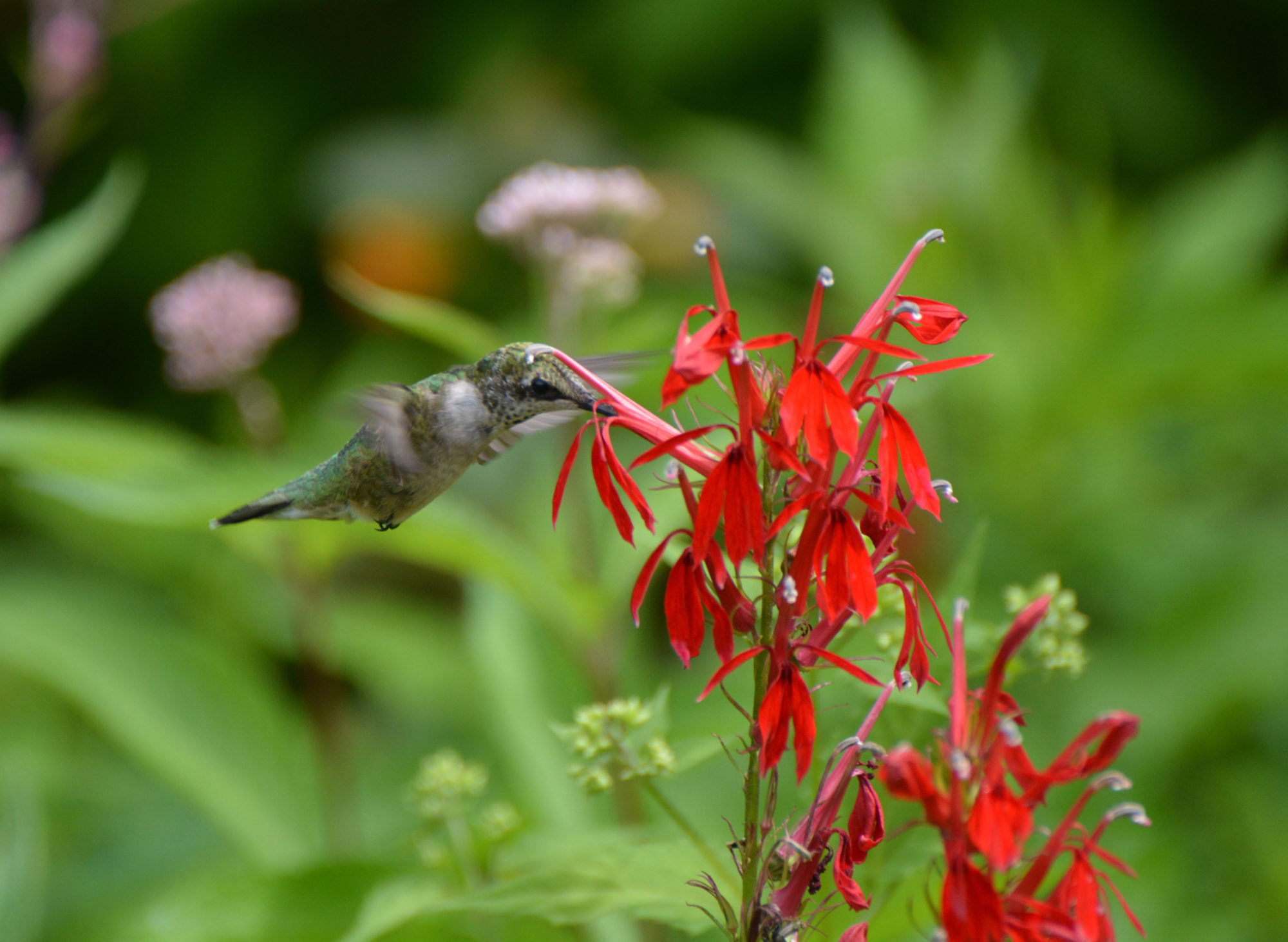We weren’t able to host our usual Show Me Help Me tours in 2020 or 2021, but we can create a virtual tour featuring a native plant that gave us joy this year! Note: All photos were taken by the contributors unless otherwise noted.
Janet Allen, Westvale

I’ve enjoyed my patches of wild bergamot (Monarda fistulosa) over the years not just because of the abundance of lavender flowers, but because they seem to attract so many of my favorite insects.
This year, I was delighted to see many black and gold bumble bees — my favorite bumble. Hummingbird moths also seem to especially like this plant.
Holly Scherzi

I first spotted Ironweed at the Plantsman a few falls ago. It was so unusual I had to purchase one. Every Spring since then I go to their spot (I now have three) and wait for them to emerge. I love to watch it’s slow but steady progress to it’s towering 4-6 ft self. In September large cluster of unusually brilliant purple flowers flowers explode into view, just about the time other flowers are starting to fade.
Marcy Kupchella, Fairport

I purchased this packera aurea from Amanda’s Garden 3 years ago and here it is this year in the last week of May. It spreads easily, so I was able to move small ones to 3 other areas in the woods garden where they are thriving.
Estelle Hahn, DeWitt

My amelanchier in bloom this past spring.
We planted it in 2010 and this is the first year that it’s tall enough that the deer didn’t eat most of the buds off before they opened. What a beautiful sight after 10 years!
Diana Green

The most exciting thing about my garden this year was the insects. I saw ones I had never seen before on my property: praying mantis, a huge walking stick, the eastern eyed click beetle and katydids.
Here’s my video of the walking stick walking!

Being a habitat gardener has made me more aware & appreciative of insects. They are so beautiful and unique. I think my garden provides them with a habitat not otherwise available in my increasingly lawn-covered, herbicide killing suburban area.
Tracy Lobo, Baldwinsville

I’m a native gardening novice, and planted my very first habitat garden last fall. I got so much joy from the garden this year, but this Penstemon digitalis was my first big profusion of blooms in early summer. I’ve since added a woodland garden, a rain garden, and a few trees – I’m hooked!
Bee Lover

I wait for the end of summer for this to flower and attract the bees and butterflies.
Louise and Mariana

My granddaughter and I regularly sit and watch our pollinator garden to see who comes to visit.
This day, Sept. 7, 2020, we each took a picture of the same butterfly visiting a purple coneflower.
Hers (four years old) is the shot from below and mine, (Grandma, 76 yrs.) from above.
We took this with my cell phone camera (iphone 11). She’s getting to be a good little photographer! And, the fun is in looking at the same scene from above and below. She and I agreed that the high up and low down views of the same thing help us both “see” better.
Cheryl Lloyd

Though Helenium autumnale “sneezeweed” is always abuzz with many bee species, an occasional butterfly will pay a visit too.
Plants begin blooming mid-late summer, prefer a sunny location and a moisture retentive soil. They form well behaved clumps that can reach a height of 5’.
I enjoyed the opportunity to photograph this cooperative, wild Monarch in my garden early in September. (Silver-spotted Skippers also relish it’s nectar).
Carol Biesemeyer, Camillus

Coneflowers dominate the garden beds next to my house, so I get an up-close look at them often through the season. They always seem slow to bloom, but when they finally do, it is glorious!
Visited by bees, wasps and moths (photo has a pyralid moth) during summer and feasted upon by flocks of goldfinches starting in late summer through mid-fall, these beauties deliver!
Coneflowers spread on their own from seed, but not too aggressively. They love the full sun in my garden and did pretty well during the dry summer we had in 2020. I did not water them!
Jim Wagner, Fayetteville

I let my Cone flower and Black Eye stalks stand for the birds to eat their seeds during the winter.
Photo: Janet Allen
Peter Huntington, Tully

Planted at Tracy Lake Nature Preserve in Tully 3-4 years ago.
It is in a moist shady area which it seems to love.
It is important when planting native plants in nature to place them in an area that has conditions similar to where they naturally thrive.
Joy Swensen, Baldwinsville

Native purple aster with honey bee in Baldwinsville.
I have read this is one of the best plants for insects in the fall due to high nutrition value.
Tess Schaufler

Exploded Milkweed.
I love my crazy, wild milkweed and other pollinator plants. Unfortunately this year I didn’t have Monarchs (last year I had a number and lots of caterpillars) but there was lots of other insect activity.
And my cousin made Christmas ornaments with the fluff and some seeds, putting that into those clear ornament bulbs that you can fill.
Sharon Tuthill

Tall Garden Phlox attract many summer visitors to our gardens including this lovely orb weaver, a female Golden Garden Spider.
